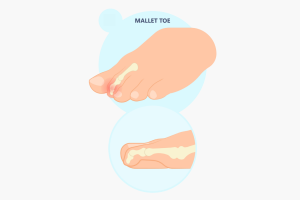Hammertoes (hammer toes) and mallet toes are a few of the most common foot conditions. In fact, research by Nextremity Solutions, Inc. indicates that forefoot deformities, such as hammertoes and mallet toes, are an endemic problem in the US, affecting as many as 20% of Americans. Additionally, these conditions are more common in women than in men, and they tend to develop later in life.
Learn more about these two conditions, including their common causes, symptoms, and treatments in the following post.
What are they?
What is a hammertoe?

Hammertoes are a common foot condition in which one or more toes bend at the middle joint, resembling a hammer. This can cause pain, swelling, redness, and corns and calluses on the affected toe or toes. It can also make it difficult to walk or wear shoes.
What is a mallet toe?

Mallet toes are a common foot deformity in which one or more toes bend at the end joint, resembling a mallet. This can cause pain, swelling, redness, and corns and calluses on the affected toe or toes. It can also make it difficult to walk or wear shoes.
What’s the difference between the two?
Here are a few of the key differences between hammertoes and mallet toes:
Hammertoes
- Bend at the middle joint of the toe
- More common than mallet toes
- Can affect any toe, but are most common in the second and third toes
Mallet Toes
- Bend at the end joint of the toe
- Less common than hammertoes
- Most common in the fourth toe
What causes hammertoes and mallet toes?
Several factors can contribute to developing hammertoes and mallet toes. Some potential causes include:
- Wearing tight or ill-fitting shoes: Shoes that are too tight or too short can put pressure on the toes and force them into a bent position.
- Having long toes: Long toes are more likely to develop hammertoes and mallet toes because they are more likely to rub against the inside of shoes.
- Having certain medical conditions: Certain medical conditions, such as arthritis, diabetes, and neurological disorders, can increase the risk of developing hammertoes and mallet toes.
- Family history: Hammertoes and mallet toes can run in families, suggesting that there may be a genetic component to the condition.
- Trauma to the toes: A fracture or dislocation of the toe joint can increase the risk of developing a hammertoe or mallet toe.
- Repetitive stress injuries: People who participate in certain sports, such as dancing or running, may be more likely to develop hammertoes and mallet toes due to the repetitive stress placed on their feet.
- Aging: As we age, the muscles and tendons in our feet can weaken, making them more susceptible to hammertoes and mallet toes.
It is important to note that the exact cause of hammertoes and mallet toes is not always known. In some cases, a combination of factors may contribute to the development of these conditions.
What are the symptoms of hammertoes and mallet toes?
The most common symptom of hammertoes and mallet toes is pain in the affected toe or toes. The pain may be worse when wearing shoes or walking. Other symptoms may include:
- Swelling of the affected toe or toes
- Redness of the affected toe or toes
- Corns and calluses on the affected toe or toes
- Difficulty walking or running
- Deformity of the affected toe or toes
Hammertoes and mallet toes can also cause pain in the ball of the foot, heel, and arch. In severe cases, the pain may be so severe that it makes it difficult to walk or stand.
How do you treat hammertoes and mallet toes?
Non-surgical Treatments
Non-surgical treatments are typically recommended for mild to moderate cases of hammertoes and mallet toes. These treatments include:
- Wearing supportive shoes with a wide toe box. This will give your toes plenty of room to spread out and reduce pressure on the affected joints.
- Avoiding high heels and other shoes that put pressure on your toes.
- Using toe pads or cushions to help protect your corns and calluses.
- Soaking your feet in warm water for 15-20 minutes at a time to help reduce swelling and pain.
- Massaging your toes gently to help improve circulation and reduce stiffness.
- Physical therapy can help to strengthen the muscles and improve the range of motion in the toes and feet.
- Orthotics are shoe inserts that can help to support the foot and toes and correct any biomechanical problems.
Surgical Treatments
Surgery may be recommended for severe cases of hammertoes and mallet toes that do not respond to non-surgical treatments. Surgical options include:
- Arthroplasty: Arthroplasty is a procedure in which the damaged joint in the toe is replaced with a plastic or metal joint.
- Tendon release: Tendon release is a procedure in which the tendon that is pulling the toe into a bent position is released.
- Bone fusion: Bone fusion is a procedure in which the bones in the toe are fused together to correct the deformity.
The type of surgery that is recommended will depend on the severity of the condition and the specific needs of the patient.
Are there possible complications with these conditions?
If left untreated, hammertoes and mallet toes can lead to several complications, including:
- Corns and calluses: Corns and calluses are thick, hardened areas of skin that can develop on the affected toe or toes. They can be painful and make it difficult to walk.
- Bursae: Bursae are fluid-filled sacs that act as cushions between bones, tendons, and muscles. When they become inflamed, they can cause pain and swelling around the affected joint.
- Infection: If the skin around the affected toe or toes breaks open, it can lead to infection.
- Deformity: Over time, the toes may become deformed and permanently bent. This can make it difficult to walk and wear shoes.
When should I see a doctor?
If you are experiencing any pain or discomfort in your toes or feet, it is important to see a specialist to receive a proper diagnosis and treatment plan. Hammertoes and mallet toes are common and treatable conditions. With early diagnosis and treatment, most people can find relief from their symptoms and improve their quality of life.
Hammertoe and Mallet Toe Treatment at AOS
At Advanced Ortho and Spine (AOS), we’ve cared for numerous patients with hammer toes and mallet toes. Most are able to get back to living their best lives with only conservative treatment. Request an appointment online or call us at 615.885.0200 to schedule yours today.

With two locations near Nashville in Mt. Juliet and Hermitage, Advanced Ortho and Spine provides patients with high-quality, personalized care while advancing orthopaedic excellence. Contact us today to learn more or to schedule your appointment.
Disclaimer: This blog provides general information and discussions about health and related subjects. The information and other content provided in this blog, or in any linked materials, are not intended and should not be construed as medical advice, nor is the information a substitute for professional medical expertise or treatment.If you or any other person has a medical concern, you should consult with your healthcare provider or seek other professional medical treatment. Never disregard professional medical advice or delay in seeking it because of something read on this blog or in any linked materials. If you think you may have a medical emergency, call your doctor or emergency services immediately.
The opinions and views expressed on this blog and website have no relation to those of any academic, hospital, health practice, or other institution.

